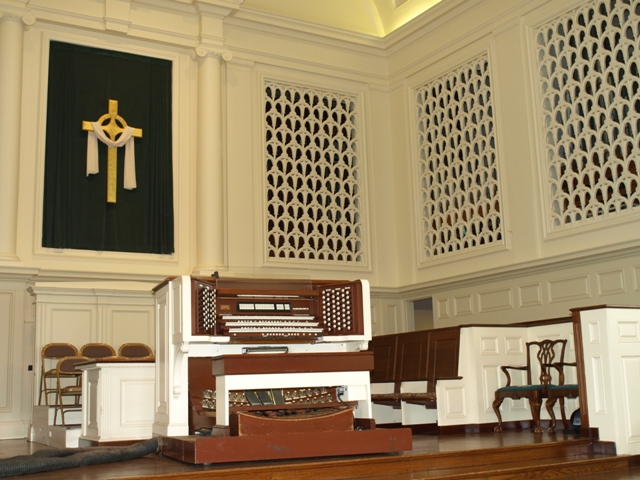
|

|
| Great | Swell | Positiv | |||
|---|---|---|---|---|---|
| 16' | Quintaton | 16' | Rohrbass | 8' | Holzgedeckt |
| 8' | Prinzipal | 8' | Viole de Gambe | 4' | Prinzipal |
| 8' | Querflote | 8' | Viole Celeste | 4' | Koppelflote |
| 8' | Bordun | 8' | Rohrflote | 2' | Oktav |
| 4' | Oktav | 8' | Flute Celeste II | 2' | Waldflote |
| 4' | Rohrflote | 4' | Principal | 1 1/3' | Quintflote |
| 2' | Oktav | 2 2/3' | Nazard | 1' | Oktavlein |
| Kornet V | 2' | Fifteenth | Sesquialtera II | ||
| Mixtur IV | 2' | Zauberflote | Scharf IV | ||
| Zimbel III | Plein Jeu III-IV | Zimbel II | |||
| Posaune | Cymbale III | 16' | Dulzian | ||
| 8' | Trompete | Terzian II | 8' | Cromorne | |
| 4' | Klarine | 16' | Petite Bombarde | 16' | Trompette en Chamade (Great) |
| 16' | Trompette en Chamade (TC) | 8' | Trompette | 8' | Trompette en Chamade (Great) |
| 8' | Trompette en Chamade | 8' | Hautbois | Tremulant | |
| Chimes | 8' | Voix Humaine | |||
| Zimbelstern | 4' | Clarion | |||
| Tremulant | |||||
| Choir | Pedal | ||||
| 16' | Erzahler | 32' | Bourdon Forte (electronic) | ||
| 8' | Spitzprinzipal | 32' | Bourdon Piano (electronic) | ||
| 8' | Gedeckt | 16' | Principal | ||
| 8' | Erzahler | 16' | Bourdon | ||
| 8' | Kleiner Erzahler (TC) | 16' | Quintaton (Great) | ||
| 4' | Principal | 16' | Rohrbass (Swell) | ||
| 4' | Lochgedeckt | 16' | Erzahler (Choir) | ||
| 2 2/3' | Nazard | 10 2/3' | Gross Quint | ||
| 2' | Blockflote | 8' | Octave | ||
| 1 3/5' | Tierce | 8' | Rohrpfeife | ||
| Mixture III-IV | 6 2/5' | Gross Terz | |||
| 8' | Holzregal | 5 1/3' | Kornet II | ||
| 4' | Rohrschalmei | 4' | Choralbass | ||
| Tremulant | 4' | Nachthorn | |||
| 2' | Nachthorn | ||||
| Mixture IV | |||||
| Scharf IV | |||||
| 32' | Kontra Bombarde | ||||
| 16' | Bombarde | ||||
| 16' | Petite Bombarde (Swell) | ||||
| 8' | Trompette en Chamade (Great) | ||||
| 8' | Trompette | ||||
| 4' | Clairon |
On Sunday, March 3, 1 957, Claribel Thomson, then Organist and Choir Director of the First Presbyterian Church of Ardmore, Pennsylvania, played the Dedicatory Recital on the M.P. Moller Pipe Organ installed in the new sanctuary of the First Presbyterian Church of Bethlehem, dedicated just one week earlier. The organ consisted of Great, Swell, Choir and Pedal divisions. There were 49 stops and a total of 3,000 pipes. The total cost was $54,000.00. A larger instrument had been envisioned, but funding would not permit the inclusion of a Positiv division. At that time the Director of Music was Stoddart Smith who served this congregation from 1950 to 1960. Dr. Elam Davies was Senior Pastor. One year later, Dr. Davies and his wife, Grace, presented a gift of Chimes to the Church, in memory of Mrs. Davies' mother and father, A few years later, the Vox Humana from the E.M. Skinner organ in the ballroom of the Eugene Grace mansion was added to the Swell division of the organ.
It was not until 1970 that major additions were made to the instrument. At that time the Director of Music was William Whitehead and under his direction, the Cassavant Freres Organ Company of Saint Hyacinthe, Quebec added a Positiv division of eight stops. One year later the same firm supplied a new Great division of nine stops.
In 1977, Greg Funfgeld, present Director of Music, began discussions with members of the Session and Staff regarding replacement of worn out leathers, repair of certain mechanical functions and tonal unification of the organ. Finally. a decision was reached and the original builder, the M.P. Mo1ler Pipe Organ Company of Hagerstown, Maryland was awarded the contract for a complete rebuilding and expansion of the present instrument. The objectives were: to retain all of the new pipework added by the Cassavant Freres company in 1970 and 1971 and to retain the most distinguished pipework from the original instrument (including the Chimes and the Vox Humana), to replace all leathers in the organ and put the instrument in the best mechanical condition possible, to unify the organ tonally and to provide an instrument capable of meeting the needs of the present Music Ministry in Worship services, accompanying choirs of all ages, recitals and concerts.
After further discussion with our consultant: Mr. Donald Gillette, Tonal Director of the Moller Organ Company, John Tyrrell, area representative of the Moller Organ Company: and Mr. Funfgeld, the present specification and design was agreed upon.